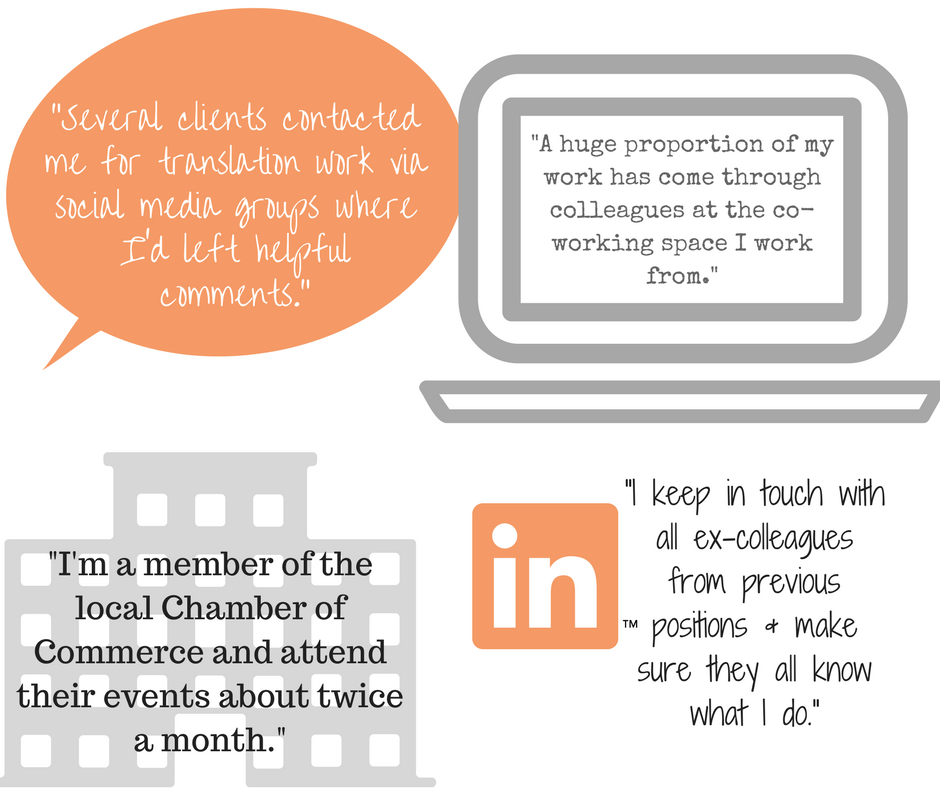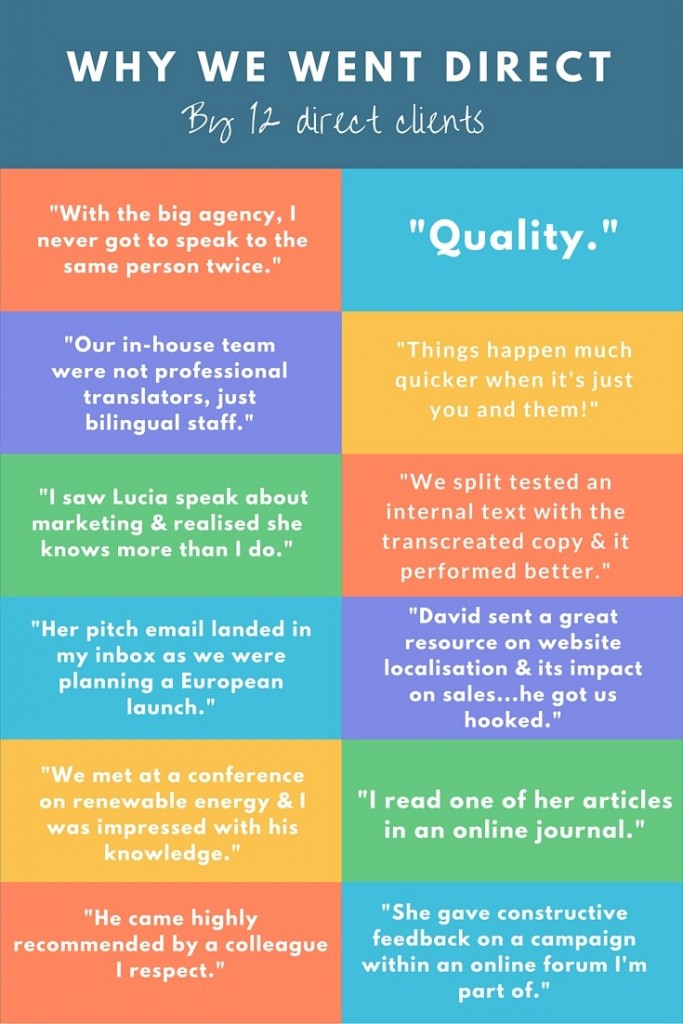Greater than 8 minutes, my friend!
10 Ideas For Getting New Clients
How has 2017 been for you so far?
Have you been rushed off your feet with new clients? Or enjoying a leisurely easing back into working after the holiday season? Maybe you’ve been busy planning for the year ahead. Lots of colleagues I know fall into that last category – myself included. I’ve had several new projects, but mostly I’ve been using my time to work out my goals and plans for the coming year, and figuring out how I’m going to achieve everything I want.
So what do you want to achieve?
For many translators the holy grail of freelancing life is to be able to work the hours they want and earn the money they need. Some choose to do this by working on their productivity, so they can take on larger volume projects, thus getting more money for the larger text.
But I’m lazy.
Although I am a big fan of tools and techniques that “make” me more time, I try to focus more on the tricks that might make me more money. Principally, this involves staying within the areas of work I feel most confident in, i.e. the ones that make me naturally productive, because I enjoy doing them and time flies when I’m working on them.
It also involves seeking clients who I feel value my services, and whose business would gain value from using them. For me, this has meant making a shift to direct clients.
But how do we get direct clients?
I know. It’s really easy to say “get direct clients” but the “doing” part, or should that be the “getting” part seems daunting and far away and…you know, hard.
I don’t know about you, but I kinda prefer things to be easy.
Having said that, it can’t be that hard, because hundreds and thousands of translators (and other freelancers) do it every single day, in all parts of the world, with all sorts of budgets (or lack of budgets), and all sorts of technical or circumstantial hurdles to overcome.
So it can be done.
In fact, a whole big group of us chatted about how it could be done last year, on our live chat about clients – you can check it out here.
Seeing as the start of the year is such a great time to set new goals for the year and really attack our strategies, I thought I would curate the top 10 techniques, tools and tips for getting new clients.
I’ve spoken to fellow translators and freelancers about their favourite tricks, and, as part of my copywriting course, I also carried out a survey of businesses who use freelance translators and outsourcers (rather than going to big agencies). I’ve included some of the information from these discussions within the points below – as ever, I hope it’s helpful!
10 tips for going direct
1. Get Googling
If you’d like your list of new clients to feature local companies then it’s a pretty good idea to get out and actually meet them (and get a personal connection going). I’ve found that local companies also feel they can “trust” local providers more than big multinationals. How did I do it? I set up Google alerts on news items with various keywords that related to my specialisms, and also used words like “Belfast”, Northern Ireland”, “Dublin”, etc to narrow the search geographically (obviously you can put in your own local area).
It took me a few tries, and I had to wade through some irrelevant stuff, but pretty soon I started to hear more about local events, achievements of local companies, new initiatives, etc. I used these as a starting point to either get in touch directly, for example, to congratulate them on a recent win, or to sign up for relevant events.
2. Conduct interviews
This one’s for translators or editors who work in academic or research fields.
Get in touch with heads of department in universities and ask them about the marking criteria, how their schools structure academic papers and their specialist research areas. It will help you improve your craft and could make valuable contacts.
Another tip for academic translators is to contact the purchasing department at universities and research institutes and ask about the process for becoming a supplier. Often, you will be provided with a supplier number, which can be a great icebreaker when chatting to members of staff, as you’re already “approved”.
3. Create a website that is only in your source language.
This is a big one (and it’s one that I haven’t personally implemented yet) but many colleagues have reported great success having done this.
It gives your source language market such a strong message about your seriousness (and competency), which in turn builds their confidence and trust in your skills.
If you’re considering this, make sure you understand fully how this would work in practice and ask yourself these questions:
- Should I consider a bilingual version of my existing site first?
- Does my existing site support another language?
- If I do have a stand-alone website in my source language (or even a version of my existing one), would I need to enlist the help of a native speaker on a regular basis for upkeep, maintenance and creation of new source language content?
- If I answered yes to the previous question – how much would that cost?
4. Learn to love Linkedin
If tip number 3 is a bit daunting at the moment, then this tip might be a good halfway house.
Translate your Linkedin profile into your source language.
Or rather, have your Linkedin profile translated into your source language by a translator colleague (you never know, you could perhaps arrange a skills swap.) I had my Linkedin profile translated last year and have found a huge benefit (and several new clients) from doing so. If your Linkedin profile is somewhat lacking, here’s a masterclass on making it better.
Linkedin is, in general, a terrific place to make contacts. Finding groups in your specialisms and contributing regularly to those is a great way to meet potential new clients. Side note: by contributing I don’t mean replying to every post with a “I’m a translator – do you need any translation services?“.
Get on potential clients’ radars by being helpful and knowledgeable – not pushy and desperate.
5. Offer your help!
Recently, I’ve been involved in a local business incubator programme. They run a programme for start ups who’ve had some success already, have good projections and (crucially, for me as a translator & outsourcer) are aiming for export.
I sit on a panel with other local businesses, and provide feedback on proposals, giving them advice/direction based on the areas I’m experienced in – so for me, I help them with copy and content writing (for example, for their websites), localisation and document translation.
Are there any similar initiatives in your area?
Here’s some information on incubators and accelerators. Even if it doesn’t bring you new clients, meeting other local businesses (established ones and start ups) is great for expanding our horizons and inspiring us to reach for more.
Data dump
Let’s take a quick break here to have a look at how translators and direct clients are “finding” each other. You’ll see from the chart that there are plenty of ways to find or be found….so you don’t just have to rely on the I’ll-just-sit-at-my-desk-and-hope approach (has that ever worked?) Here’s a slight expansion on the responses from the chart…just in case they aren’t clear from the titles:
Outbound i.e. the translator reached out to the client
At an event
By searching an online database, e.g. Translators Cafe, Proz, etc
Translator speaking at an event
Internet search & found translator’s website
Word of mouth, i.e. the translator was recommended
6. Try the Chris Durban approach for finding new clients.
Once you’ve identified potential contacts, get in touch to ask if they would help with terminology for a glossary you’re creating for clients, then offer to send them a copy when you’re done.
I’ve done this successfully for a knitting expert I wanted to work with (and I learnt a lot of new terminology too!) There’s some more detail on this approach in Chris’ book The Prosperous Translator.
7. Speaking at an event
I know even the thought of getting up in front of a roomful of people can be scratch-your-eyes-out scary, but it is a terrific way to showcase your expertise and make new contacts.
Whether you’re speaking about the translation/localisation/interpreting process and how it fits within a certain sector, or whether you choose a different topic within your specialist subject, positioning yourself as a contributor to the conversation is an excellent way to keep you front of mind with new clients.
I’ve found that something that helps me when the haters be hatin’ (even if the haters only exist in my mind) is that I am contributing to a conversation. I’m not trying to position myself as an expert; I’m not a guru, nor am I the font of all knowledge, but I do have useful, insightful information to provide that businesses and individuals may benefit from.
You do too.
8. Write on, dude!
If speaking at an event is (at the moment) a step too far, how about getting your knowledge out there in written format? Writing for relevant magazines and journals is another great technique for showcasing your expertise and getting in front of potential new clients.
But how do you actually do it? Pitching to magazine or website editors can be intimidating, and it’s hard to know how much or how little to say. Edinburgh conference interpreter, Jonathan Downie (of Integrity Languages), recently put together a brilliant step-by-step guide to writing pitches – here’s a link.
9. Work on your website
Sometimes, it’s about letting new clients come to you. Are you receiving many work requests through your website? Maybe it’s time to have a look at it, and ensure it’s working as hard as you are.
I look at structuring your web copy in my course, and I’ve talked about it for eCPD Webinars, because your website really should be another powerful weapon in your marketing strategy. Here are some links to get your website working for you.
Writing Copy for your Business Website
Getting to Grips with Google Analytics
Full disclosure: the first two links take you to the eCPD website which have the videos for two webinars I did for them. However, I don’t receive any money for your purchases, should you decide to make them (don’t worry – I did get paid at the time!) The last link is to a blog post here on the Silver Tongue site.
10. Get out there
At the Let’s Talk Clients live chat we had a few months ago, word of mouth didn’t just feature prominently in our panellists and contributors’ strategies for getting new clients, it won by a country mile. Here are just some of the ways colleagues have been meeting (and making) contacts and getting recommended:

I mentioned earlier that I’d interviewed colleagues and clients (not just mine, I promise!) about how they found each other. Something that came up while I was chatting to the clients was how they felt their lives had also been improved by, in their words, “going direct”. And that’s something we forget.
Going direct works both ways.
We get so tied up in the benefits for us of cutting out the middleman, avoiding the bottomfeeders, going boutique not bulk….we forget about all the advantages for the client too. There are numerous benefits for businesses when they choose to work with an individual rather than a big multinational. I could go into them…or I could just let them tell you themselves (in a pretty graphic, of course.)

Pretty cool, huh?
I created a handy action plan to help you implement these 10 ideas into your strategy for the coming months. Just fill in your details to receive it.




